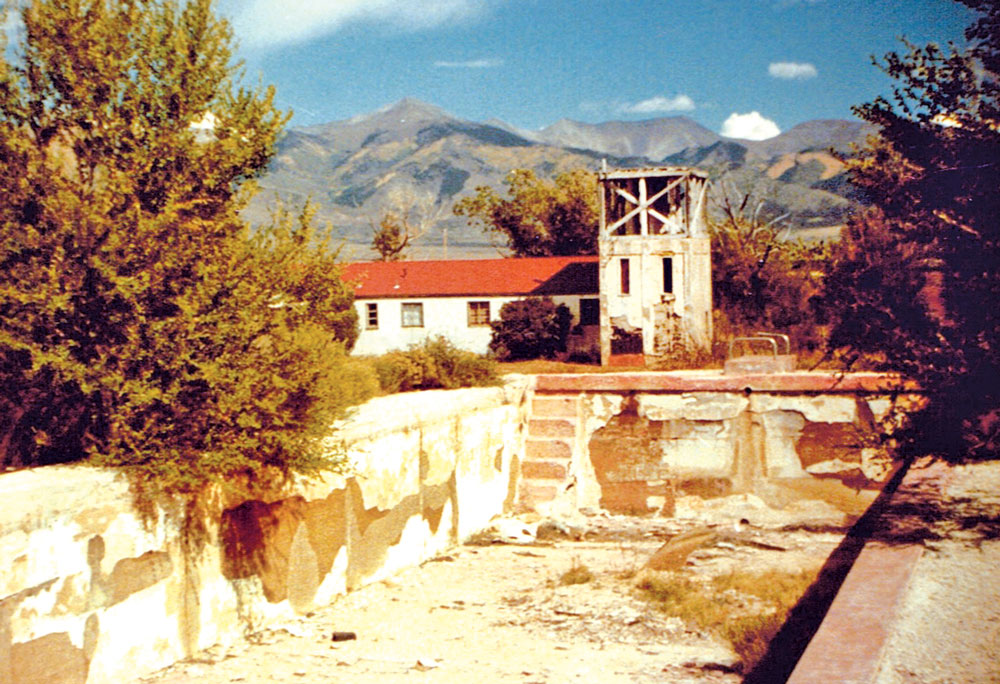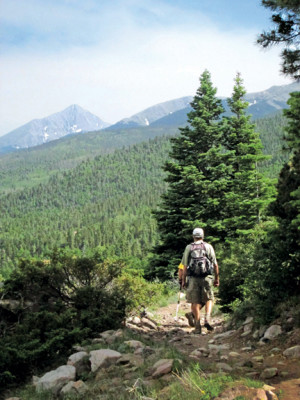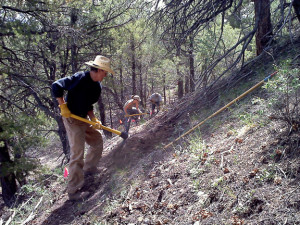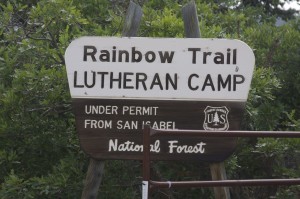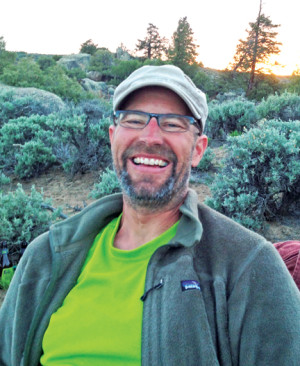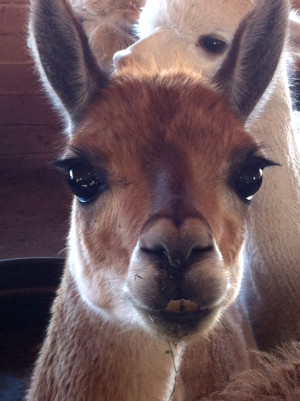By Mike Rosso
Isolation is often the first impression when arriving at Joyful Journey Hot Springs.
The resort, located south of Villa Grove in the northern San Luis Valley, consists of a modern hotel, health spa, geodesic greenhouse, hot soaking pools, yurts and teepees. It resides amidst vast fields of rabbitbrush and sage. To the west lie the Sangre de Cristo Mountains, a vast beacon in this high mountain valley, the largest and highest in North America.
What is not apparent is the unique history of this seeming oasis: that it was once platted to become a vibrant city and health resort; that the railroad passed through for many years. The largest population at one time consisted of swine; and that for a short while, it was a place to maintain a hippie lifestyle among the crumbling structures, soaking naked in the remains of the baths, away from most of the comforts – and problems – of modern society.
In part one of the story of Hot Springs City, an earlier developer of the resort, Robert Dunshee, passed away, not having realized his dreams of a thriving resort community. The rail stopped running in the early 1950s and the resort sat, alone and mostly abandoned. The post office remained until 1946 and at some point, the resort was purchased by Elmer Walker.
Little information can be found about Elmer Walker and the resort he ran up until the late 1950s. Virginia Sutherland, former director of the Saguache museum, remembers swimming at the pool as a child. Another longtime Villa Grove resident, Mary Moore, remembers she used to “mess around as a kid” at the pool, but not much else.

Courtesy of Victor Summers.
Bob Bunker, a fifth-generation San Luis Valley native, lived as a child in the old post office building at Mineral Hot Springs from about 1957-59. Bob worked on water well rigs on the Baca Grande for 21 years. His father, Earl, was a rancher in the area. He remembers the post office closing soon after the train stopped running in the early 1950s. When they lived there, Elmer Walker was still running the resort. Walker’s son Phillip and his wife operated a cafe and the pool. The cafe was a small place, around 600 square feet. Bunker remembers that it cost about 40-50 cents to soak and swim. Locals came from all around to enjoy at the springs. He recalled diving boards at the facility and that the water came in hot with a continuous flow. He also remembered a four-room motel and a very old, hollowed- out two-story hotel on the premises. That hotel can be seen in the background of several photos published in the July issue of Colorado Central. Bill and his family moved to Moffatt around 1960.
An article in the Valley Courier, dated June 1965, notes the owner of the Mineral Hot Springs resort at that time to be [InContentAdTwo]R.J. Wright, who in addition to the pool and bathhouse, operated a restaurant and the service station, had spaces for 12 trailer homes, and maintained 12 sleeping spaces. The 22- by 90-foot enclosed warm- water pool was still in operation. Heated concrete walks bordered the pool. The enclosure had a glassed-in balcony for spectators, and the bathhouse consisted of ten private rooms and a lobby. Wright offered a Mother’s Day special, presenting homemade frosted cakes and cards to the moms who, along with their children, were admitted to the springs at no charge that day. The service station closed around 1964, but the building is still on the premises today.
During the late seventies and into the late eighties, the abandoned resort became popular with members of the counterculture. The wide open expanses and “free” hot springs were great incentives for those looking to drop out of
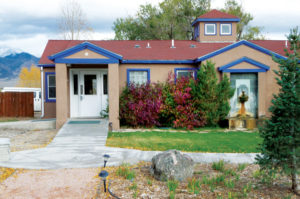
mainstream society. Students at Adams State College and the Air Force Academy all enjoyed soaking at the springs as well. Mark Jacobi, current facilities manager at Valley View Hot Springs, up the road from the old resort, described the place as “raw.” “The wind barriers were made of old airplane cloth and rattled like all get out when it blew. Like a soup pot, everybody ended up soaking their bones there. It would be a real treat of a day when you decided it was time to make the drive from Crestone, and you never knew what mix of folks had the same idea … we once occupied the tub with a bunch of Buddhists who had just come out of a month-long retreat, and we all shared a bottle of sake that we floated from person to person. In the winter it was a race to strip and jump in before the cold took you. There never was any heat and clothing was optional … in the summers, snakes would glide in and out of holes in the adobe walls, and birds would squawk and wheel. You always slept like a log and dreamt like Jung after.”
Caren Kershner is one of only two permanent residents at Mineral Hot Springs, the other being her son, Avery Runner. Caren was a 32-year-old single mom when she discovered Mineral Hot Springs back in 1978. She came to Colorado from Ohio in the mid-1970s, and after spending time in Boulder, heard about the San Luis Valley After camping out at the Great Sand Dunes, she discovered the remains of Mineral Hot Springs. The resort had long been abandoned, and the only residents were hippies who occasionally took residence in the old buildings.
Caren liked the vibe of the place so much she moved herself and her two children, Avery and Carey, into a small trailer on a private lot next into the old post office. After a year or so, this modern-day pioneer moved herself and her children in a primitive three-room cabin – the only remaining structure from the original Hot Springs City – while commuting to Adams State College to take classes. Initially the cabin had no electricity and was heated by an old woodstove. Eventually she was able to borrow money to purchase the old post office and hotel, as well as several city lots from the Davies family of Monte Vista. In 1982 she drilled a well and built a pump house. She then brought in a single-wide trailer to move herself and her family into – a big upgrade from the old cabin. Over the next thirty years, she saw many changes in the community while teaching in Moffat. For a while, a pig farm moved into the neighborhood. A large number of boxcars, estimates of around 80, were brought in and retrofitted with cement floors. Hot water was then run through the cars to create a favorable environment for about 800 pigs. More on that later.
In 1990, Caren had a new house built on her property– a bright and sunny two-story, passive solar clerestory-style home, where she still lives today. The old post office has long since been torn down, but the original cabin is still out back. She has two hot springs wells on her property; one runs about 98 degrees, and the other varies from 108-114 degrees. She is now retired but is actively involved with the San Luis Valley Local Foods Coalition and is currently giving presentations throughout Colorado on industrial hemp cultivation.
Darrell Alexander was the state USDA Inspector for 22 years; before that, he ran a pig farm north of Mineral Hot Springs from 1978 through 1982. He and his family moved to the San Luis Valley from Texas in 1956 and operated a hay farm. He remembers soaking at the swimming pool and bathhouse when he was young. “It was the best hot water of ‘em all,” he said of the springs. “It would just melt you.”
Owned by the MM&G Cattle Company of Fort Morgan, the North Chamberlain Swine Unit processed around 250 feeder pigs per week. On average, there were nearly 45 boars and 850 sows on the premises. But the heated boxcars didn’t quite work out – they were just too hot and steamy for the pigs, and the cars had to constantly be washed and disinfected. Those problems, along with the difficulty of finding grain and the logistics of shipping, proved to be too much. The operation was shut down in 1982. The boxcars were sold back to the original seller, Floyd Reed, who then hired a salvage guy from CF&I in Pueblo to dismantle them. At first, the cars were cut up to be hauled away, but after only two or three cars were removed in nearly three years, a huge machine arrived, complete with clamping jaws and a hydraulic shear. This machine literally lifted the remains of the cars and shook out all the remaining wood and concrete. The metal shells were then loaded onto a flatbed truck and hauled away in a matter of days. Nothing remained of the pig farm after that.
In the early 1980s, Rock Ridgeway was heading south, back to Texas, after a season doing craft fairs in Colorado. When he got to the junction of Highways 17 and 285, he hesitated. What he was really looking for was a “nice cool cave.” After heading south on Hwy. 285 for about a half-mile, he turned back and took Hwy. 17 south. A low gas gauge caused him to stop. He then saw a sign for the hot springs advertising $8 rooms. He stayed for two weeks and then returned to Texas, where he spent two years “divesting of his possessions.” He moved back to the Valley and rented a place at Mineral and “set up a little factory and dying operation.”
Rock ended up as caretaker of the place, setting up shop in the old motel. He then began operating a clothing company, Cameleon, and created a multi-functional garment, trimmed and dyed at the springs and sewn in La Jara. Locals from Moffat and Crestone worked for Rock during this time, often finding their hands stained purple from a day’s work. At the time the main pool was still functioning with a donation box to help defray costs. “It was basically free and nekkid,” he explained. Friends and strangers stopped by from all around to soak at the remains of the old resort and channel their inner-hippy during those free-wheeling days.
Showering at the facility was a dangerous prospect at that time; the water became hotter and hotter the longer it ran. The original buildings still remaining on the property all had radiators which ran off of steam heat generated by the thermal hot springs. The temperature of the water coming from the ground was 145 degrees and was tempered with cooling tanks. Rock made some improvements to the facility, such as glass walls around the pool to cut back the wind. This technique is still in use at the current facility. He also started a small library in the old motel.
When the property was sold to Dick and Elaine Blumenhein in 1987, Rock left to fulfill his own visions. He currently lives in Crestone and continues to operate Cameleon Clothes.
Dick Blumenhein, a Boulder-based developer, had been wanting to purchase a hot springs resort since the 1960s. He and his former wife, Elaine, owned a second home in Crestone, where they came down with their children. Dick was one of the original developers of the Pearl Street Mall in Boulder. His company, the Oasis Land and Cattle Company, purchased the run-down and decaying facility in the 1987 from the MM&G Cattle Company. Along with the resort, they purchased about 500 surrounding acres and most of the remaining city lots with the goal of protecting the hot springs. Thus came the end of the open-door, anything goes policies of the previous caretakers. The new owners set about to restore and rebuild the hot springs. Dick envisioned something along the lines of a new-age, organic health resort. The old motel was torn down and in its place, a trailer was brought in where a series of caretakers lived.
In 1993, Victor Summers and Lotus McElfish were hired to help get the resort up and running again. Both had previous experience doing restoration at hot springs resorts such as Glen Ivy and White Sulfur Springs in California. They decided to move to Victor’s home state of Texas to start an herbal spa. On their way, they stopped in Colorado and suddenly found themselves managing the Avalanche Ranch in Redstone. A friend of theirs from Crestone had met Dick Blumenhein; they gave him their resumes which he passed on to Dick, who tracked them down and offered them jobs. They accepted and relocated to the hot springs. Jon Worden, an architect out of Crestone, was hired, as well as a contractor from Moffat. Together they set upon a complete restoration of the facility. It was renamed Mineral Hot Springs. Incorporating the old cooling tower into the design, they built both indoor and outdoor pools, as well as decking, and retrofitted the existing bathhouse with geothermal in-floor heating. Design elements of the Walker-era facility were incorporated; long-hidden baths were exposed in the bathhouse. The facility reopened in 1996, with Victor and Lotus as proprietors.
Two years later, the Blumenheins split up, and Elaine decided to move down and take over operation of the resort. One of her first priorities was to remove the remaining derelict buildings and restore the land surrounding the hot springs. Shortly after, the name was changed to Joyful Journey Hot Springs. “I remember the first time I got into the springs. I felt that this was happy, joyful water. This is how I came up with the name. As I see it, we are all on a journey on this earth, and this is a stop along the way,” she said in an article which ran in The Newsboy in 2008.
She added a campground facility with restrooms, and added teepees and yurts available to rent. A geodesic greenhouse was also constructed. Currently there are three outdoor soaking pools with temperatures ranging from 98 to 108 degrees. The therapeutic, healing waters contain magnesium, lithium, calcium, boron and arsenic. A redwood-paneled dry sauna and therapy rooms are located in the bathhouse along with changing rooms, showers and snacks.
In 2008, an 11-room lodge was added, along with a 100-seat conference center available for meetings, workshops, weddings and other events. Elaine hopes to eventually add a private soaking pool for lodge guests, as well as several additional pools. She envisions the facility to become as self-sustaining and self-reliant as possible – even envisioning a kind of elder-care center.
Relaxing in the southernmost pool, the hottest of the three, visitors can watch the sun set on the Sangre de Cristo range and imagine what once was. Few traces remain of the early days of Hot Springs City, but it is easy to conjure the spirits of the Native Americans and early settlers – maybe even Robert Dunshee – as one marvels at the surrounding peace, tranquility and rich red color of the “blood of Christ mountains” at dusk.
Spa Hours: 9 am – 10 pm, 7 days a week
www.joyfuljourney.com
719-256-4328 • 1-800-673-0656

